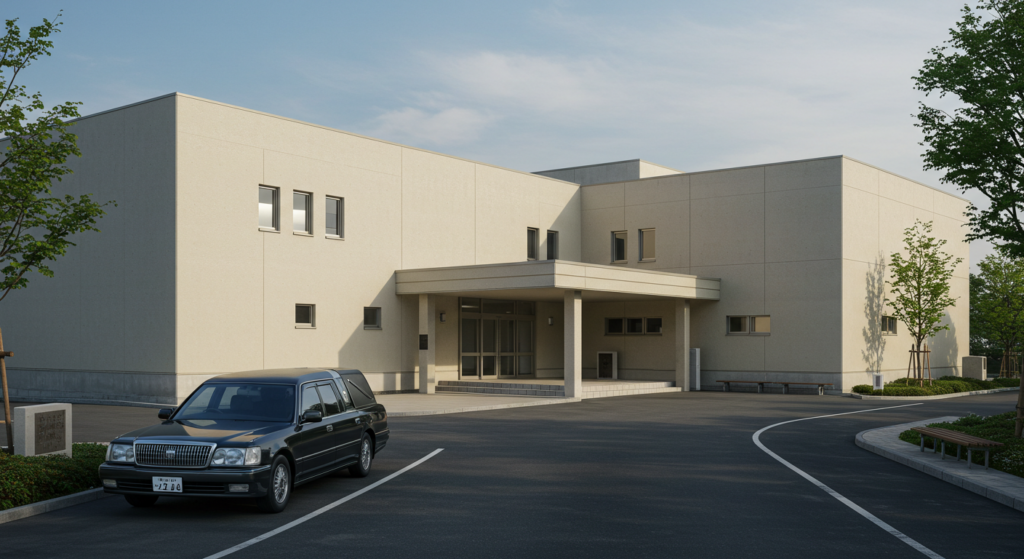Introduction

In Japan, funerals often cost anywhere from several hundred thousand yen to over a million yen. Many funeral service providers add various options such as altars, venue fees, catering, and return gifts, which can significantly increase the final cost beyond the original estimate.
However, in recent years, due to an aging population, the rise of nuclear families, and a diversification of values, there is an increasing demand for options that are “as low-cost as possible” or “simply enough to bid farewell to a loved one without extravagance.” One such option that has attracted attention is the use of public crematoriums and public funeral services.
You might be wondering:
- “What exactly are public crematoriums and public funerals?”
- “How do they differ from private funeral services?”
- “Do they really save money, and does the quality suffer as a result?”
In this article, we answer these questions and explain the benefits and considerations of using public crematoriums and public funerals, as well as tips for maintaining a satisfactory level of service while keeping costs down. If you want the farewell to your loved one to be as memorable as possible, please read on.
1. What Are Public Crematoriums and Public Funeral Services?
1-1. Overview of Public Crematoriums
A public crematorium is a facility operated by a local government (municipalities or prefectures). Unlike privately run crematoriums, public ones are subsidized by tax revenues, allowing residents to use them at a very low cost.
- Low Resident Rates
Many public crematoriums offer subsidized rates for residents. For example, in Tokyo, prices can range from about 2,000 to 10,000 yen, while in Osaka City, the cost might be around 10,000 yen. - Higher Fees for Non-Residents
However, if you are not a resident of the municipality where the crematorium is located, the fees can be significantly higher. For instance, at Tokyo’s Mizue Funeral Hall, the fee for district residents might be 7,000 yen, while non-residents could pay several tens of thousands of yen.
1-2. Overview of Public Funeral Services
Public funeral services are plans offered directly by local governments or through designated funeral service providers that offer low-cost funeral options. They are typically operated under names such as “[City Name] Public Funeral” or “Municipal Funeral Plan.”
- Set Packages
These plans usually include not only cremation but also a set of basic items such as altars, body transport, dry ice, etc. The total cost is often around 100,000 to 200,000 yen. - Usage Conditions
Often, a key requirement is that you must be a resident of that municipality. In addition, depending on your income or family composition, further subsidies may be available.
1-3. Comparison with Private Funeral Venues
| Item | Public Crematoriums/Public Funerals | Private Funeral Venues/Private Crematoriums |
|---|---|---|
| Operating Body | Local government (tax-supported) | Funeral companies and related private enterprises |
| Cost for Residents | Very affordable (a few thousand yen to low tens of thousands) | Generally higher (cremation fees in the tens of thousands or more) |
| Service Content | Basic facilities and simple services | Various optional and luxurious services available |
| Availability | Non-residents may face higher fees or restrictions | Generally available to anyone, though busy periods may have wait times |
| Facility Numbers | Limited; may have long waiting times during busy periods | Numerous; selection is easier even during peak periods |
2. Benefits of Using Public Crematoriums and Public Funeral Services
Benefit 1: Lower Costs
The biggest advantage is cost reduction. Some municipalities offer cremation for residents at a few thousand yen to around 10,000 yen, and if you use the public funeral plan, the total cost can be kept to around 100,000–200,000 yen. In contrast, a typical private funeral can cost from 500,000 to over 1,000,000 yen, offering significant savings.
Benefit 2: Guaranteed Minimum Service Quality
Although there’s a common perception that “low cost equals low quality,” public facilities adhere to strict governmental standards regarding equipment and hygiene management. This ensures that the essential aspects, such as cleanliness and basic facilities, are well maintained so that you can use them with confidence.
Benefit 3: Resident Discounts and Municipal Support
Some municipalities offer additional support measures, such as not only “resident discounts” but also subsidies for low-income households or funeral assistance for those receiving public assistance. This means that the lower the household’s economic standing, the greater the benefits of using public services.

3. Points to Note When Using Public Crematoriums/Public Funeral Services
Point 1: Difficulties in Reserving a Slot During Peak Periods
While public crematoriums are affordable, they tend to be crowded. In winter, when death rates tend to increase, reservations can be booked up quickly, sometimes requiring waiting periods of several days to over a week.
- Reservation Wait Times: It’s not uncommon to have to wait several days or even a week.
- Limited Service Options: During busy periods, you may be limited to shorter usage times, which can restrict the time available to bid farewell.
Point 2: Municipality-Specific Conditions
Public crematoriums and funerals are generally designed to favor residents of the municipality. If you are not a resident, you might face significantly higher cremation fees—ranging from tens of thousands to even hundreds of thousands of yen. Additionally, there may be conditions such as:
- Example: A requirement to have lived in the city for a certain number of years or exclusions for recent transplants.
- Example: Subsidies or discounts might only be applicable for funerals held within the same municipality, with no discount for services from nearby cities.
Point 3: Limited Flexibility
Public facilities may not offer the same level of customization or elaborate presentation as private venues. For instance, if you want to set up a large altar or use video presentations, such requests might be restricted by municipal regulations. Thus, these services are best suited for those who prefer a simple, dignified funeral.

4. Tips for Achieving a Satisfying Farewell While Keeping Costs Down
Tip 1: Identify the Essentials
Funeral expenses generally include the following key items:
- Cremation fee (facility usage fee)
- Venue rental fee
- Costs for altars, coffins, dry ice, and other necessary supplies
- Transportation fee for the body
- Personnel costs (staff)
- Catering and return gifts (if applicable)
Start by identifying the absolutely essential items (such as the cremation fee and coffin) and carefully evaluate whether the additional services are truly necessary. This can lead to savings of tens of thousands of yen.
Tip 2: Value “Time for Farewell” Over Venue Size
The idea that “a grand hall equals a magnificent funeral” may be outdated. More and more people are finding that a small, intimate farewell with just close family can be more meaningful.
- Family or Small-scale Funerals: Many public facilities or small public chapels allow you to rent just enough space for a family funeral.
- Direct Cremation + Farewell Gathering: After the cremation, consider holding a separate farewell gathering at another location. This approach can reduce costs while still providing a meaningful opportunity to share memories.
Tip 3: Carefully Choose Optional Extras
When arranging a funeral through a private funeral service, you may be presented with various optional extras (upgrading the altar, floral arrangements, offerings, photo processing, etc.). Although it might feel inappropriate to cut costs during such times, these optional extras can add up significantly.
- Reconfirm What Is Truly Desired: Evaluate whether these options are truly reflective of the wishes of the deceased and the family.
- Price Comparison: Request detailed estimates and categorize options into “essential,” “nice-to-have,” and “unnecessary.”
Tip 4: Utilize Online and Digital Tools
Since the COVID-19 pandemic, remote participation and online memorial services have become more common. This allows distant relatives or busy friends to attend the service virtually, reducing the need to invite a large number of people while still creating a heartfelt farewell.
- Live Streaming: Use smartphones or tablets with tools like Zoom to broadcast the service live.
- Video Messages: Collect video messages from those who cannot attend in person and compile them into a montage.
- Social Media or Dedicated Memorial Sites: Share photos and memories of the deceased in an online space.

5. Procedures and Flow of Public Funeral Services
Step 1: Check Your Local Government’s Website or Consultation Desk
Start by checking your municipality’s official website for information on public funerals, using keywords such as “public funeral,” “crematorium fees,” or “chapel usage.” If the information isn’t readily available online, contacting your city hall or public health office is advisable.
Step 2: Confirm Whether a Public Funeral Plan Is Available
Some municipalities operate only public crematoriums without offering a complete public funeral plan. In those cases, you might use a public crematorium while arranging the funeral through a private provider. Also, note that some municipalities may offer public funeral plans through designated service providers, so be sure to check.
Step 3: Consult a Funeral Director or the Municipality’s Designated Provider
- Reservation of the Public Crematorium:
In many cases, funeral directors will handle the reservation for you. If you wish to make the reservation yourself, you can typically use the telephone reservation system provided by your municipality. - Obtain a Cost Estimate:
Clearly state that you intend to use a public funeral plan and prefer a simple family or direct cremation service, and request a detailed estimate that includes any optional extras.
Step 4: Confirm the Schedule and Flow on the Day of the Service
- For a Service with a Wake and Farewell Ceremony:
Follow the schedule set by the public funeral plan. Keep in mind that there may be time limits on venue usage, so confirm details such as the meeting time and duration of the farewell. - For Direct Cremation or a Small Family Service:
Since only minimal preparations are required, the process may be very short. Although the farewell time might be limited, a smaller group can help focus the sentiment.

6. Example Costs for Public Funeral Services
Below are some examples from various municipalities. Note that actual prices may change, so always confirm the latest information on official websites.
6-1. Example from the 23 Wards of Tokyo
Tokyo’s 23 wards have municipal crematoriums, though in practice, some are operated by private designated management companies (e.g., Tokyo Hakuzan).
- Cremation fee for residents: Approximately 7,000 to 10,000 yen
- Non-resident usage: Can cost from 50,000 to over 100,000 yen
- Public Funeral Plans: Often available on a ward-by-ward basis, typically costing around 100,000 to 250,000 yen
6-2. Example from Osaka City
- Osaka City’s Kitasaijo:
For Osaka residents, the cremation fee is around 10,000 yen. - Public Funeral Plans: Osaka City offers set plans through designated providers, with prices typically in the 100,000 to 150,000 yen range.
6-3. Example from Yokohama City
- Yokohama Municipal Chapel:
For Yokohama residents, the cremation fee is about 12,000 yen. - Public Funeral Plans: Depending on the details, these generally cost around 150,000 to 200,000 yen.

7. Q&A: Frequently Asked Questions
Q1: Can I use a public crematorium in another municipality?
A: Although it is often possible, you will lose the resident discount, and fees can be significantly higher. For example, a non-resident using a 23-ward crematorium in Tokyo might pay from several tens of thousands to over 100,000 yen. Additionally, some municipalities strictly reserve services for residents, so be sure to check in advance.
Q2: What happens if I am receiving public assistance?
A: For recipients of public assistance, “funeral assistance” may be available. Under certain conditions, direct cremation (cremation-only) can be performed either free of charge or with subsidies up to around 200,000 yen. Consult your local welfare office for details.
Q3: Does “public” mean “cheap and inferior quality”?
A: Public facilities maintain the minimum necessary standards for equipment and hygiene. While they may not offer the luxurious venues or detailed services provided by private companies, they are entirely adequate for ensuring a respectful farewell.
8. Conclusion: Making the Most of Public Facilities for an Affordable Farewell
For those looking to dramatically reduce funeral expenses or who prefer “a simple yet heartfelt farewell,” using public crematoriums and public funeral services is an excellent option. For residents, cremation fees are very low, and choosing a public funeral plan can keep total costs within 100,000 to 200,000 yen—a significant saving compared to the 500,000 to 1,000,000+ yen typically charged by private services.
That said, factors such as booking difficulties, limited customization, and residency conditions mean that early and thorough research is essential. Compare multiple municipalities and funeral service providers to select the style that best suits you and your family.
Actionable Steps Right Now:
- Check Your Local Government’s Website:
Search using keywords like “public funeral,” “crematorium fees,” or “chapel usage” to learn about the available services and conditions. - Obtain Multiple Estimates from Funeral Directors:
Even when using a public crematorium, reservations are often handled through funeral directors. Compare prices and service plans carefully. - Discuss with Family and Relatives:
Talk in advance about whether a direct cremation (cremation-only) is sufficient or if you would like to include a wake or farewell gathering. - Consider Online Memorial Services or Remote Participation:
Use digital tools to enable participation from distant relatives or busy friends, ensuring that the farewell remains personal yet cost-effective.

Final Message:
Public crematoriums and public funeral services provide an excellent way to keep funeral costs manageable while maintaining essential quality standards. This option is particularly beneficial for families on a tight budget or for those seeking a simple, dignified farewell.
The key is not merely about cutting costs but about carefully deciding “how to send off a loved one and where to invest your heartfelt intentions.” Even if the facility is simple, ensuring that family and close friends have the opportunity to share their farewells can result in a meaningful and regret-free service.
If you’re concerned about the high costs of traditional funerals or uncertain about choosing a service provider, consider exploring public crematoriums and public funeral services. You might just find the option that offers both affordability and the satisfaction you desire.
Related Blog Posts and Reference Links:
- Recent Funeral Trends – The Modern Approach to Funerals
- “What Are Police Cases?” → “Understanding Police-Related Body Retrieval and Why Funeral Directors Handle It”
- A Comprehensive Guide to Traditional Japanese Funerals: Process and Characteristics
Reference Links:
- Ministry of Health, Labour and Welfare “Trends in Deaths”
https://www.mhlw.go.jp/ - Tokyo Metropolitan Bureau of Social Welfare
https://www.fukushihoken.metro.tokyo.lg.jp/ - Osaka City Hall
https://www.city.osaka.lg.jp/ - Yokohama City Hall
https://www.city.yokohama.lg.jp/ - Public Chapel Navigator Sites (Private websites listing public chapels by municipality; simply search for “public chapel” or “public crematorium search”)
In Conclusion: Embracing Modern Funeral Options
Funeral styles have significantly evolved over recent years. While in the past it was common to have large-scale, multi-day ceremonies, today options such as family funerals, direct cremations, and remote participation are commonplace.
At the same time, many are increasingly concerned about costs and do not want to forgo a proper farewell due to financial constraints. For such individuals, public crematoriums and public funeral services can be a real “savior.”
Even without elaborate decorations, if family and close friends can come together to share their heartfelt goodbyes, a simple service can be just as fulfilling.
Consider exploring these options if you’re worried about high funeral costs or uncertain about which provider to choose. You may find a way to hold a meaningful, budget-friendly service that meets your family’s needs.
next,
・A Guide to Japanese Funerals: Traditions, Processes, and Costs



